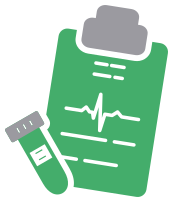Cáncer de mama
Notas sobre el tablero
Los resultados de los estudios de mastografía son expresados en el sistema de clasificación BI-RADS
| Clasificación | Categorías del sistema BI-RADS y su descripción |
|---|---|
| BI-RADS 1 | Sin hallazgos |
| BI-RADS 2 | Hallazgo benigno (no canceroso) |
| BI-RADS 3 | Hallazgo posiblemente benigno |
| BI-RADS 4 | Anormalidad sospechosa |
| BI-RADS 5 | Anormalidad que sugiere un hallazgo maligno |
Notas sobre el tablero
BI-RADS es definido como el Sistema de reporte de información radiológica para la imagen de la mama (del inglés Breast Imaging Reporting and Data System); desarrollado por el Colegio Americano de Radiología (American College of Radiology, ACR).
Notas sobre el tablero
Los datos presentados son el resultado del programa de Seguimiento a mujeres con sospecha de cáncer de mama de Salud Digna A.C.
Los resultados de los estudios de mastografía son expresados en el sistema de clasificación BI-RADS
BI-RADS 4: Anormalidad sospechosa
BI-RADS 5: Anormalidad que sugiere un hallazgo maligno
Antecedentes familiares de cáncer de mama7 edad, factores reproductivos como edad temprana de la menarquia y el primer embarazo, mayor densidad mamaria8 factores hormonales, consumo de algunos anticonceptivos orales, terapias hormonales, diabetes, obesidad, tabaquismo, consumo de alcohol, consumo de café, poca actividad física, exposición a radiación y agentes contaminantes (cancerígenos)8,9,10,11,12,13,14,15.
- Augustyn, A. (2022). Breast cancer. Encyclopaedia Britannica. https://www.britannica.com/science/breast-cancer
- NBCF. (n.d.). What is Breast Cancer? National Breast Cancer Foundation, INC. Retrieved September 12, 2022, from https://www.nationalbreastcancer.org/what-is-breast-cancer/
- Alkabban, F., & Ferguson, T. (2022). Breast Cancer. StatPearls Publishing. https://www.ncbi.nlm.nih.gov/books/NBK482286/
- MedlinePlus. (2022). Breast Cancer. MedlinePlus: National Library of Medicine. https://medlineplus.gov/breastcancer.html
- Centros para el Control y la Prevención de Enfermedades. (2021). Cancer de mama. CDC. http://cdc.gov/spanish/cancer/breast/basic_info/mammograms.htm
- Instituto Mexicano del Seguro Social. (2015). La Mastografía. Gobierno de México. http://imss.gob.mx/salud-en-linea/cancer-mama/mastografia
- Colditz, G., Rosner, B., & Speizer, F. (1996). Risk Factors for Breast Cancer According to Family History of Breast Cancer. Journal of the National Cancer Institute, 88(6).
- Momenimovahed, Z., & Salehiniya, H. (2019). Epidemiological characteristics of and risk factors for breast cancer in the world</p>. Breast Cancer: Targets and Therapy, Volume 11, 151–164. https://doi.org/10.2147/BCTT.S176070
- Anothaisintawee, T., Wiratkapun, C., Lerdsitthichai, P., Kasamesup, V., Wongwaisayawan, S., Srinakarin, J., Hirunpat, S., Woodtichartpreecha, P., Boonlikit, S., Teerawattananon, Y., & Thakkinstian, A. (2013). Risk Factors of Breast Cancer. Asia Pacific Journal of Public Health, 25(5), 368–387. https://doi.org/10.1177/1010539513488795
- Anderson, K. N., Schwab, R. B., & Martinez, M. E. (2014). Reproductive risk factors and breast cancer subtypes: a review of the literature. Breast Cancer Research and Treatment, 144(1), 1–10. https://doi.org/10.1007/s10549-014-2852-7
- Britt, K. L., Cuzick, J., & Phillips, K.-A. (2020). Key steps for effective breast cancer prevention. Nature Reviews Cancer, 20(8), 417–436.
- Coughlin, S. S. (2019). Social determinants of breast cancer risk, stage, and survival. Breast Cancer Research and Treatment, 177(3), 537–548. https://doi.org/10.1007/s10549-019-05340-7
- Lo, P.-K., & Sukumar, S. (2008). Epigenomics and breast cancer. Pharmacogenomics, 9(12), 1879–1902. https://doi.org/10.2217/14622416.9.12.1879
- Nathanson, K. N., Wooster, R., & Weber, B. L. (2001). Breast cancer genetics: What we know and what we need. Nature Medicine, 7(5), 552–556. https://doi.org/10.1038/87876
- Singletary, S. E. (2003). Rating the Risk Factors for Breast Cancer. Annals of Surgery, 237(4), 474–482. https://doi.org/10.1097/01.SLA.0000059969.64262.87

